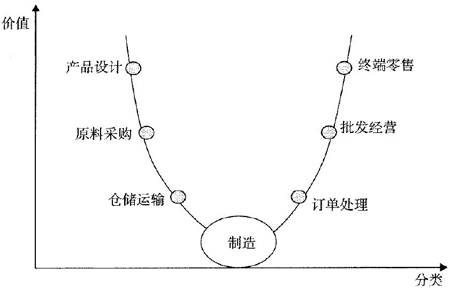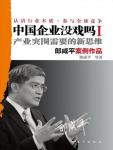Chapter 1 New Strategic Thinking for Breakthrough of Consumer Goods
Since 2009, I have intensively published three case books on industrial chain conspiracies——"Industrial Chain Conspiracy I, II, III", which are deeply valued by readers. I am deeply grateful for the enthusiastic support of readers.But I have also received many letters from readers, and everyone unanimously hopes that I will talk about how Chinese companies should break through under such an impact. Therefore, this is the purpose of my writing this case collection.
First of all, I would like to talk about what an industrial chain is based on in the past.Taking Figure 1 as an example, the traditional industrial chain is a smiling curve, including six non-manufacturing links such as product design, raw material procurement, warehousing and transportation, order processing, wholesale operation, and terminal retail, plus the manufacturing link. I believe readers should be familiar with the "6+1" industrial chain theory that I have been promoting in recent years.
In the case of "Industrial Chain Conspiracy I, II, III", I pointed out that taking Figure 1 as an example, in the past we only knew that manufacturing was at the bottom of the smiling curve, and the value of manufacturing was the lowest. higher than manufacturing.But we never know why, this is because the new imperialist industrial capital has strictly controlled the cost of each link after controlling the six major links of the industrial chain.Let me take Foxconn, which has been booming recently, as an example. The real black hand behind it is Apple's hegemony.Why can Apple have such hegemony?This is because Apple is at the highest level in the industry chain, and it firmly controls all key points in the industry chain, that is to say, the key points in this chain are all connected by Apple.Apple will directly negotiate with various component manufacturers and place orders directly with each component supplier at the lowest price. The purchased parts will be sent to Foxconn’s assembly plant for assembly on time according to Apple’s requirements, and the assembled Apple takes care of what process is used for each step, how long it takes, and how many materials are used.

Figure 1 The value smile curve created by the "6+1" link of the traditional industrial chain
Let me give you an example. Apple’s method of calculating labor costs is the minimum wage at the location of the manufacturer X the maximum working hours for each product. Foxconn has no way of determining labor costs.In addition, after 13 consecutive suicide cases, Foxconn announced a substantial salary increase in June 2010. Behind this salary increase is actually the shadow of Apple.Only because Apple gave Foxconn 1 point of profit, Foxconn was able to raise wages.
Let me give another example. In August 2009, Jiang Haoliang, one of Guo Taiming's hand-picked successors, suddenly left Foxconn's front-line core business and became a special assistant.Before he joined Foxconn, he worked for Apple for 16 years.After being dug into Foxconn by Guo Taiming, he became the person in charge of Apple's orders through the relationship of the year.The former "Apple man" was kicked out by his old company simply because he didn't listen to Apple's words on the cost control of a small iPhone part.It is said that the call for a replacement was made directly to Guo Taiming-the general manager wants to come down, or he won't do business with you.This is how Apple strictly controls every link of the industrial chain, thereby controlling the pricing power of products. It is precisely because he completely sucks up the profits of our manufacturing industry that our manufacturing is squeezed to the bottom of the smile curve. .
New imperialism also appeared in the form of financial capital, controlling the pricing power of agricultural and mining products. Interested readers can read my other two new books and .These two books describe in detail how financial capital can control the cost of raw materials in China's manufacturing industry by controlling the pricing power of the two major resources of agriculture and mining.
I drew Figure 2 in the book "Industrial Chain Conspiracy III", which shows that the new imperialism first controlled the pricing power of agricultural and mineral products through financial capital, and then controlled the sales pricing power through industrial capital, thus attracting This is the reason why the gross profit margin of my country's traditional manufacturing industry is low.The final conclusion of the industrial chain conspiracy series is that our reform and opening up has achieved a dazzling GDP, while the new imperialism has obtained most of its profits through financial capital and industrial capital.Therefore, the more China develops and the more China manufactures, the richer the new imperialism becomes.

Figure 2 New imperialism exploits China's manufacturing industry through financial capital and industrial capital
The most frequently asked question by readers is how Chinese enterprises should break through under the double attack of industrial capital and financial capital.My answer is very simple, it is impossible to break through to the right of Figure 2, because the level of our financial capital can be said to be very different, they are too powerful.For example, the Greek crisis in 2010 was the result of Wall Street attacks. I will discuss this topic in future works.Our only way out is to ask industrial capital for pricing power.Of course, doing so is far from enough, we need to further grasp the nature of the industry.So are there any successful cases of Chinese companies that we can learn from?This is the purpose of my case collection.
I specifically picked out a few consumer goods industries. These industries must grasp the essence of the industry and the integration of the industrial chain at the same time to break through.Please note that an enterprise with the nature of an industry must be an enterprise that faces consumers.I divide the status quo of China's consumer-facing companies' breakthroughs into the following types of discussions.
Red wine and tea - Chinese companies are breaking through.
Women's shoes, sports shoes - Chinese companies have successfully broken through.
Online shopping - as long as this industry grasps the essence of the industry, then they can survive in the Chinese market.
I would like to remind readers that although Chinese companies are temporarily unable to break through in some industries, we will discuss in detail how to break through.
Of course, intermediate industries that do not face consumers but face other industries basically only have the problem of the industrial chain rather than the nature of the industry, such as the mining, cement, construction machinery and other intermediate industries we discussed in "Industrial Chain Conspiracy III" .The characteristic of these industries is that they do not face end consumers, so the integration of the "6+1" industrial chain is the most important. Interested readers can refer to "Industrial Chain Conspiracy III" to understand the technical aspects of the industrial chain integration of intermediate industries The details will not be repeated here.
However, some consumer-facing industries do not have the problem of the industrial chain, they only have the problem of the essence of the industry, so as long as they grasp the essence, they can survive in the Chinese market.These industries basically do not involve manufacturing, so industrial chain integration is not important. For example, the network industry, which I classify as the fourth type of industry.I have hardly talked about this industry in the past research. In this book, I specially found a case to discuss for readers.But if it is about the computer software industry, it will involve the issue of the industrial chain, so interested readers please refer to "Industrial Chain Conspiracy I" and "Industrial Chain Conspiracy II".
The content of this book is very exciting. I don’t need to discuss too much in the preface. Interested readers can read each chapter to further understand the details of these industry breakthroughs.Compared with the industrial chain conspiracy series, this book is very easy to understand. I believe that most readers will not have difficulties reading this book.In order to facilitate everyone's reading, I specifically selected the well-known consumer goods industry to explain, and at the same time, I also paid attention to enhancing the readability of the text.
I simply categorize the industry essence and industrial chain of each industry into the table below for readers' reference.
All the cases in this book were completed by students of the Chinese University of Hong Kong under the guidance of Professor Lang Xianping and Assistant Professor Sun Jin, and with the assistance of Assistant Cai Wenjuan. We list the names of these students below.In addition, Professor Lang Xianping thanked the China Guanghua Science and Technology Foundation for the research funding provided by the Innovation Fund, which enabled the successful completion of this large-scale research project.

Figure 1 The value smile curve created by the "6+1" link of the traditional industrial chain

Figure 2 New imperialism exploits China's manufacturing industry through financial capital and industrial capital

